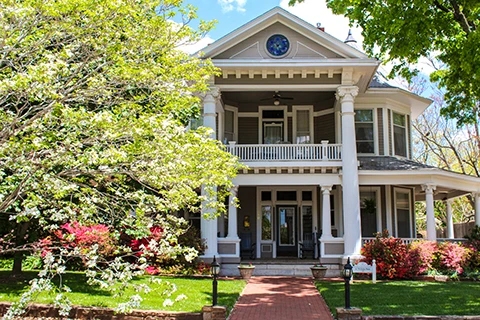
 When Marilyn Heifner talks about America in Bloom, what comes to mind is community pride. Pride when the judges come to visit, and pride when looking at their increased quality of life.
When Marilyn Heifner talks about America in Bloom, what comes to mind is community pride. Pride when the judges come to visit, and pride when looking at their increased quality of life.
The biggest benefit for the city, says Heifner, executive director of the Fayetteville Advertising and Promotion Commission, is the thorough evaluation the judges give through the six AIB criteria of overall impression, environmental efforts, heritage preservation, urban forestry, landscaped areas and floral displays. “The judges are extremely knowledgeable about a lot of things,” she says.
For the entry fee, the Arkansas city gets 10 times the value through the judges’ extensive report, Heifner says. Taking advice from one of the early reports, the city hired an over enforcer and later hired a second. The over enforcers have done tree inventories for the city’s annual tree giveaway and established a tree preservation ordinance.
The AIB committee teamed up with the police department and junior high school for a program to remove graffiti from property around town. That was successful and turned into a public art project, and now they’re painting all of the city’s utility boxes and the storm drains.
Fayetteville, a town of approximately 77,000 people, has won numerous AIB awards since 2002, and is one of 11 cities in the Circle of Champions.
The pride that Fayetteville residents get from the program, Heifner says, means that “a lot of people have started planting flowers and developing their own gardens,” in addition to volunteering with the local AIB program. Heifner says that the pride contributes to other city efforts to preserve the past and create sustainable initiatives like LED light bulb giveaways and recycling initiatives. Some food-related programs focus on growing and distributing produce and teaching students the importance of healthful food, with demonstration gardens at schools.
Their AIB program has also been helpful in bringing the community together. “The community becomes publicly driven, not politically driven,” she says. “That’s been great as far as bringing together diverse elements. I’m one of the poster children for that.” She explained that 20 years ago, Fayetteville had a contentious issue that divided the community, with Heifner leading one side. After coming together as a community through their AIB organization, the two sides realized they had a lot in common and are now working together, she says.
Heifner, who has been involved with AIB since it started in 2002 and is on the board of directors, says that the best AIB training comes from attending the national conference. “You can learn so much from them and you can see the efforts that others have made,” she says.
While the rewards are many, it’s a steep learning curve to start, and a lot of work to prepare for the judges. In addition to creating a book on what they’ve done, they also need to carefully plan an itinerary to highlighting their accomplishments. “In the end, it’s worth it even if you don’t win the top prize,” she says. “Your community wins. It improves the quality of life for the citizens.”
The author is a freelance writer in Westfield, New Jersey.
Get curated news on YOUR industry.
Enter your email to receive our newsletters.
Explore the September 2014 Issue
Check out more from this issue and find your next story to read.
Latest from Lawn & Landscape
- Aphix acquires Curb Appeal Landscaping in Birmingham
- Project EverGreen helps revitalize Milan Park in Detroit
- Trex Company wins Product of the Year, Judges’ Choice Winner at Environment+Energy Leader Awards
- General Equipment & Supplies in Fargo adds Takeuchi equipment
- Mariani Premier Group acquires Hazeltine Nurseries
- EnP Investments adds Mark McCarel as Northeast territory sales manager
- Our April issue is now live
- Ready or not






